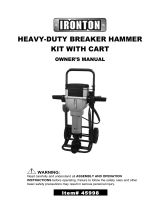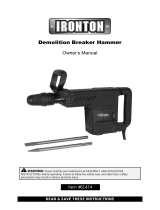POWE10090 EN
Copyright © 2018 VARO P a g e | 5 www.varo.com
▪ Store power tools, when not in use, out of the reach of children and do not allow people
who are not familiar with the power tool or these instructions to operate it. Power tools are
potentially dangerous in the hands of untrained users.
▪ Maintenance. Check for misalignment or jammed moving parts, breakages or any other
feature that might affect the operation of the power tool. If it is damaged, the power tool
must be repaired. Many accidents are caused by using poorly maintained power tools.
▪ Keep cutting tools sharp and clean. Properly maintained cutting tools with sharp cutting
edges are less likely to jam and are easier to control.
▪ Use the power tool, accessories and cutting tools, etc., in accordance with these
instructions and in the manner intended for the particular type of power tool, taking into
account the working conditions and the work which needs to be done. Using a power tool
in ways for which it was not intended can lead to potentially hazardous situations.
6.5 Service
▪ Your power tool should be serviced by a qualified specialist using only standard spare
parts. This will ensure that it meets the required safety standards.
6.6 For safe operation
▪ We recommend that you take appropriate measures for the protection of hearing if the
sound pressure of 85 dB (A) is exceeded.
▪ Keep the work area clean. Cluttered areas and benches invite injuries.
▪ Consider work area environment. Do not expose power tools to rain and do not use power
tools in damp or wet locations. Keep the work area well lit. Do not use power tools where
there is a risk to cause fire or explosion.
▪ Guard against electric shock. Avoid body contact where possible with earthed or grounded
surfaces (e.g. pipes, radiators, ranges, refrigerators).
▪ Keep children away. Do not let visitors touch the tool or extension cord. All visitors should
be kept away from work area.
▪ Store idle tools. When not in use, tools should be stored in a dry, high or locked place, out
of reach of children.
▪ Do not force the tool. It will do the job better and more safely at the rate for which it was
intended.
▪ Use the right tool. Do not force small tools or attachments to do the job of a heavy duty
tool. Do not use tools for purposes not intended, for example, do not use circular saw to
cut tree limbs or logs.
▪ Dress properly. Do not wear loose clothing or jewellery as they can be caught in moving
parts. Rubber gloves and non-skid footwear are recommended when working outdoors.
Wear protective hair covering to contain long hair.
▪ Use safety glasses. Use a face or dust mask as well if the operation is dusty or if using in
enclosed spaces.
▪ Do not abuse the cord. Never carry the tool by its cord or yank it to disconnect it from the
socket. Keep the cord away from heat, oil and sharp edges.
▪ Secure your work. Use clamps or a vice to hold your work. It is safer than using your hand
and it frees both hands to operate tool.
▪ Do not overreach. Keep proper footing and balance at all times.
▪ Maintain tools with care. Keep cutting tools sharp and clean for better and safer
performance. Follow instructions for lubricating and changing accessories. Inspect tool
cords periodically and if damaged have repaired by an authorized service facility. Inspect
extension cords periodically and replace if damaged. Keep handles dry, clean and free
from oil and grease.
▪ Disconnect tools. Disconnect when not in use, before servicing and when changing
accessories such as blades, bits and cutters.












